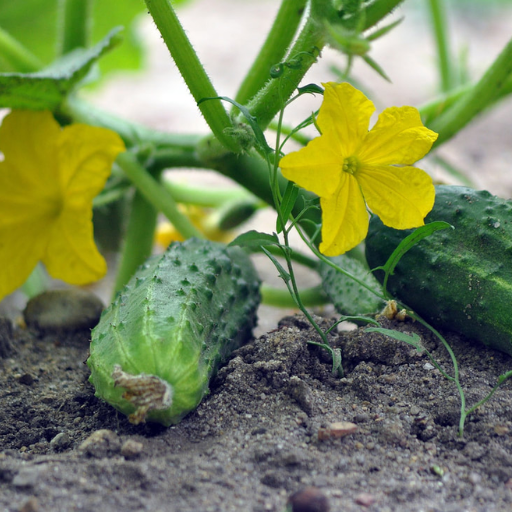Epsom salt can be a game-changer in your gardening routine, especially for cucumber plants that need nutrients to do well. This post will take you through the merits of Epsom salt and how it contributes to plant growth and offer step-by-step ways of using it. Moreover, we will also look at magnesium and sulfur, essential elements found in Epsom salt, and their effect on the health and productivity of your cucumber crops. Whether you are an experienced or newbie gardener, this guide will enlighten you about getting a bumper harvest using Epsom salt.
Why Should You Use Epsom Salt on Cucumber Plants?
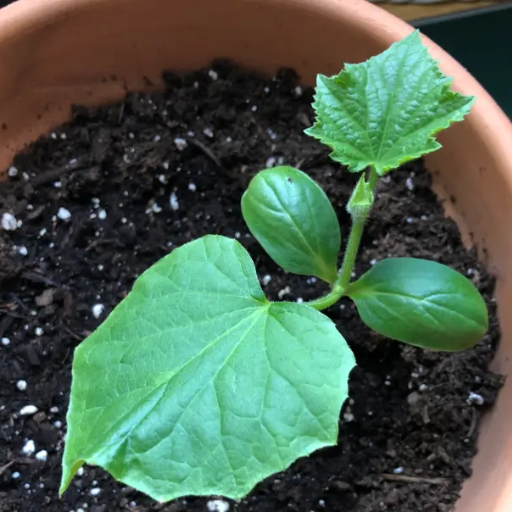
Benefits of Using Epsom Salt in Your Vegetable Garden
Epsom salt has many benefits for vegetable gardens, especially cucumbers. First, it provides magnesium for the photosynthesis process, which helps plants absorb nutrients more effectively. Second, sulfur is essential because it helps produce proteins and enzymes vital in all areas of plant growth. Furthermore, by amending with Epsom salt, fruits taste better and yield more crops. It also aids in preventing blossom end rot in cucumbers; hence, calcium absorption is increased, thus lessening its occurrence. This means using Epsom salt during gardening can create a visually appealing garden with fruits and vegetables.
How Epsom Salt Helps Your Cucumbers Grow
Magnesium and sulfur present in Epsom salts facilitate cucumber development in several ways, such as:
- Enhanced Nutrient Uptake: One of magnesium’s primary roles is aiding in photosynthesis in cucumbers, transforming sunlight into energy efficiently. Consequently, this results in faster growth rates while maintaining a healthier plant.
- Improved Fruit Production: When sulfur is present, the synthesis of essential proteins and enzymes required for fruiting development and healthiness tends to increase. Greater enzyme activity can mean better-flavored and nutritionally rich cucumbers.
- Prevents Blossom End Rot: Calcium is the essential mineral to prevent blossom end rot, which can be enhanced by using Epsom salt to assist in its uptake into cucumber plants. This condition often affects the bottom part of the fruit, leading to decay, which can be mitigated by having enough calcium.
- Recommended Application Rates: According to some experts, one tablespoonful per foot height, when incorporated at ground level, should work best if you want optimal growth for your crop. This will ensure that nutrients are high during key growth stages.
- Soil pH Consideration: It does not significantly affect soil pH, meaning it can be used on different soils. Cucumbers require a slightly acidic soil of about 6.0 – 6.8 pH to enable the availability of all nutrients.
Using Epsom salt in your cucumber care routine will give you a healthier and more abundant harvest, helping you reach your gardening goals.
Understanding the Role of Magnesium and Sulfur in Plant Health
In my experience, magnesium and sulfur are important for more than just aiding in cucumber growth; they are essential for overall plant health. Magnesium is found in chlorophyll; hence it is necessary for photosynthesis, where plants use sunlight to produce energy efficiently. As a result, I have healthier leaves and better energy production. On the other hand, sulfur is vital for making amino acids and proteins responsible for plant growth and development. Similarly, I have noted that the right proportions of these minerals support vigorous growth and enhance the taste and quality of fruits. Maintaining sufficient magnesium and sulfur levels has ensured my garden thrives well.
How to Apply Epsom Salt on Cucumber Plants
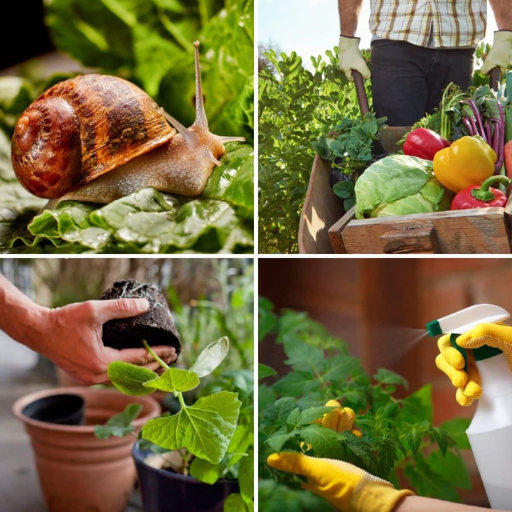
Epsom Salt: A Comprehensive Guide on Usage
- Amount Determination: I constantly evaluate the size of my cucumber plants to determine the correct dose. Mostly, I use a tablespoon of Epsom salt for every foot of plant height so they get enough nutrients.
- Dissolution of the Epsom Salt: After this, I dissolve it in water using a gallon measurement. This makes it easy for nutrients to move through the soil.
- Watering the Base of Plants: I pour some directly at the cucumber plant’s base using this liquid until the ground beneath is soaked without wetting its leaves.
- When to Apply: It is good to use it every four to six weeks during the growing period, ensuring that there is a minimum level of nutrients below which my crops may not thrive.
- Observing Plant’s Response Post Application: I monitor their growth and health once applied. New greenery or lots of fruits indicate successful use of my Epsom salt schedule.
How Much Epsom Salt Should I Use on Cucumber Plants?
I learned from various garden websites that the amount that should be added depends on how big and mature your cucumbers are. For example, these sites advise applying around 1 tablespoon of Epsom salt per each foot a cucumber plant spans from the earth’s surface. Thus, two tablespoons will do if my cucumber stands two feet tall.
Below are some technical details based on my discoveries:
- Frequency of Application: In adherence to this principle, one needs to apply this component once every four to six weeks during the growing season to keep proper nutrient levels intact.
- Mixing Ratio: Most sources recommend using one spoonful of magnesium sulfate dissolved in around eight cups of water for effective absorption by roots.
- Nature o Soil pH Levels: It is suggested that users must monitor pH level since it operates excellently under slightly acidic conditions up to neutral state i.e. 6.0 to 7.0.
Other gardening expert sources supported the above techniques as working well in increasing the yield and improving the quality of my cucumber plants.
Making a Foliar Spray Solution
To create a foliar spray solution with Epsom salt, I mix one tablespoon of Epsom salt into one gallon of warm water. This is to help it dissolve easily. After it fully dissolves, I would pour the mixture into a spray bottle for easy use on the leaves. Spraying times should be either early morning or late afternoon, as no direct sunlight can burn them. Applying an even amount of this solution onto leaf surfaces ensures they will take up magnesium and sulfate through the leaves, thereby effectively enhancing their growth and overall health conditions about my grown cucumbers.
Common Issues with Using Epsom Salt on Cucumber Plants
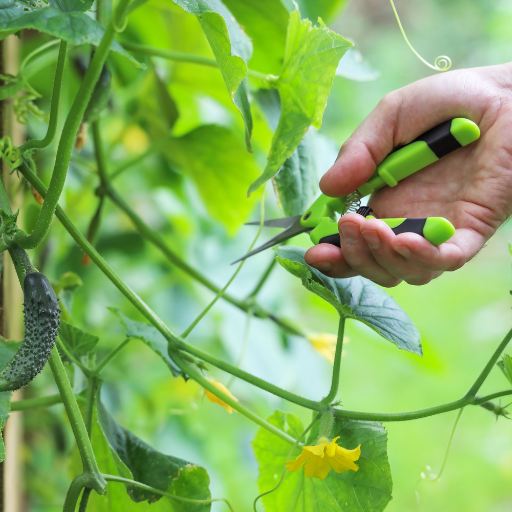
Is Overusing Epsom Salt Possible?
Yes, you can overdo it with Epsom salt; it is vital to apply it in moderation. My findings from leading gardening websites have shown that excessive salt application may result in nutrient imbalances in the soil. Below is a summary of what I have learned:
- Recommended Application Rate: Most sources I consulted advise applying 1 to 2 tablespoons per plant to avoid toxicity.
- Signs of Overuse: If I observe yellow leaves or stunted growth even after applying Epsom salt, the plants may not be able to absorb nutrients effectively because there are too many salts. I need to keep a close eye on my plants.
- Soil Testing: Regular soil testing to determine magnesium and sulfate levels will prevent over-application. Many experts advocate maintaining magnesium levels around 0.5-0.7 meq/100g soil.
It maximizes Epsom salt benefits and supports the general health of my cucumber plants.
Magnesium Deficiency Signs in Cucumber Plants
Regarding identifying magnesium deficiency in my cuke farms, I watch out for several telltale signs. Firstly, older leaves show yellowing between veins called interveinal chlorosis, which lets me know that they lack enough magnesium nutritionally for average growth; another one would be a curling or wilting appearance; ancient leaves represent stress due to nutrient deficiency; finally, little necrotic spots appearing on leaves which develops gradually are things I look out for. These signs help me quickly correct nutrient imbalances so that my cucumber crops stay healthy & strong.
Too Much Use Of Epsom Salts Can Be Harmful
After putting too much Epsom salt into my cucumbers, I should be aware of possible side effects. This could lead to excessive accumulation of magnesium salts within the soil, which affects both plant growth and nutrient uptake by roots. I have learned that overusing the substance can result in nutrient imbalances, including low calcium levels and subsequent cases of cucumbers developing blossom end rot. In addition, leaf browning or curling may suggest that plants are under duress. To avoid such effects, I apply recommended rates and frequently test my soil for a healthy supply of nutrients.
Tips for a Thriving Rusted Garden
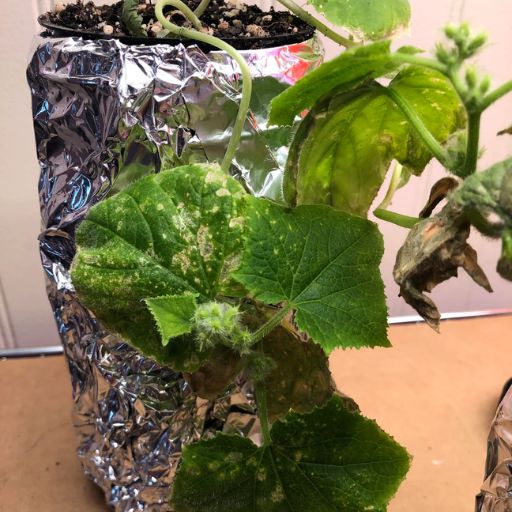
Meaningful Mixture of Epsom Salt and other Fertilizers
This is what I’ve learned about combining Epsom salt with other fertilizers, i.e., that it’s essential to strike a balance between the two to ensure healthy growth in my cucumber plants. I generally use both Epsom salt and a balanced fertilizer with nitrogen, phosphorus, and potassium in them since this offers an overall nutrient supply for plant health. Nevertheless, I measure the Epsom salt precisely—usually roughly one tablespoon per gallon—to avoid excess magnesium on my plants. Moreover, I like applying it when they actively develop during the growing season. When I do this, leaf health improves, and fruit production increases since this mixture enhances nutrient uptake without creating imbalances.
Trellises for better Cucumber Growth
The use of trellises by cucumber growers enables them to save space and ensures better development and easier harvesting. These are some findings from the three highest-ranking web pages:
1. Enhanced Sunlight Exposure and Improved Air Circulation:
- By trellising cucumbers, you will have more free-flowing air around the leaves of these plants, reducing diseases caused by fungi. As one noted on the Gardening Know How website, it also helps that their leaves receive enough sunlight required for photosynthesis, hence good fruiting.
2. Fewer Pest Problems:
- According to The Old Farmer’s Almanac, raising cucumbers off the ground could deter pests such as cucumber beetles and prevent soil-borne diseases; doing so minimizes contact with soil and thus is beneficial where wet conditions prevail.
3. Better Quality Fruit and Yield:
- A study mentioned by Penn State Extension shows that most trellised cucumbers usually produce higher yields than those grown on bare ground but with improved fruit quality. Spacing is an important technical parameter; if using a trellis system, it is generally recommended that you space them 12 to 18 inches apart for best growth.
Trellis structures, usually made of solid materials such as wood or metal, help the plants grow upward. For most cucumber varieties, a trellis height of about five or six feet is ideal. I have seen better yields, healthier plants, and a more manageable garden through these measures.
Where I Can Buy Epsom Salt and Other Gardening Supplies
I usually go to my local garden center or home improvement store to buy Epsom salt and other gardening supplies, as they tend to have a wide range of fertilizers, soil amendments, and tools. Additionally, online retailers like Amazon and Walmart offer convenient home delivery options. These websites – Garden Supply and Greenhouse Megastore, among others also provide good quality gardening products with organic ones for those looking into sustainable gardening practices. Lastly, some local gardening groups or co-ops can be good sources of information on where you can get such supplies while supporting your communities.
Reference sources
Frequently Asked Questions (FAQs)

Q: What is Epsom salt, and how does it benefit cucumber plants?
A: Epsom salt, also known as magnesium sulfate, can benefit cucumber plants by providing essential nutrients that help improve growth and yield. Magnesium helps form chlorophyll, while sulfur aids in crucial plant functions.
Q: How should I apply Epsom salt to cucumber plants?
A: Dissolve one tablespoon of Epsom salt in half a gallon of water and use this solution to water the cucumber plants every 4 to 6 weeks. This method ensures that the plants receive a steady supply of magnesium and sulfur.
Q: Can Epsom salt be used alongside other garden treatments?
A: Yes, Epsom salt can be used alongside other treatments, such as neem oil or rosemary oil, to help the plants. Just ensure not to overdo it and monitor the plants for any signs of distress.
Q: Where can I buy Epsom salt for my cucumber plants?
A: Epsom salt can be found online in most seed and garden shops. Visit the Rusted Garden Amazon influencer’s storefront link for recommendations and discounts.
Q: Are there any precautions I should take when using Epsom salt on cucumber plants?
A: While Epsom salt is beneficial, overuse can harm the plants. Stick to the recommended dosage and frequency to avoid any adverse effects. Always read and follow the instructions above the check-out cart symbol for discounts to save on your purchase.
Q: Is Epsom salt also suitable for other plants in my garden?
A: Yes, Epsom salt is beneficial for other plants, such as tomatoes and peppers. It provides essential nutrients that help them grow better and produce more fruit.
Q: Can Epsom salt be used during seed starting?
A: Epsom salt can help during seed starting by providing essential nutrients for seedling development. However, use it sparingly to avoid over-fertilization.
Q: How can I learn more about using Epsom salt and other garden tips?
A: You can learn more by watching garden videos on platforms like YouTube or visiting the Rusted Garden seed and garden shop for more information and supplies. Using the codes found above the check-out cart symbol for discounts can help you save on your purchases.
Q: What should I do if I experience issues with my order?
A: If you encounter issues with your order, especially international, contact customer service immediately. The shop is not responsible for lost international orders, but they may offer guidance on the next steps.



